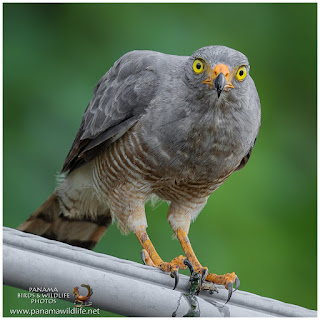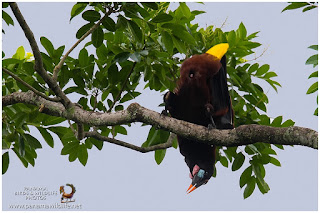I've been in Bocas del Toro Province several times, I've made road trips, motorcycle travels and vacations but never before I've been making pictures. During some visits I've seen species that are special for this region and therefore I already knew what my main targets of this trip were (Green Ibis, Brown Jay, Passerini's Tanager, Montezuma Oropendola). I knew where to find them but anyway took with me a copy of "A Bird-Finding Guide to Panama" book as an aid. I spent one full day plus half a morning in the lowlands near the town of Chiriquí Grande, and spent a couple of hours on the highlands, close to the continental division. The pictures below show the results of this exploration.

I started in Chiriquí where I photographed this common Roadside Hawk (Rupornis magnirostris) while he was enjoying a juicy caterpillar. Later, my first exploration in Bocas del Toro was in the Petroleum Tanks Road where I had a total of three Plumbeous Kites. As you can see in pictures, the day was cloudy and outcast. Around this road and the main road to Chiriquí Grande I observed Fasciated Tiger-Herons, Purple Gallinule, Green Heron, Thick-billed Seed-Finch, Northern Barred Woodcreeper, White-winged Becard, and heard Uniform Crake, White-throated Crake and Little Tinamu. Also discovered a male Slaty Spinetail constructing a nest, which was mission impossible to photograph. During the day I got intermittent showers.
Slaty Spinetail nest under construction (cell phone photo)
The Plumbeous Kite (Ictinea plumbea) is uncommon on both slopes and breeds in Panama, migrating to South America in non breeding season. Flocks of migrants from farther north pass through Panama. Frequently soars, catching insects in flight; often perches in tops of tall trees.
The
Thick-billed Seed-Finch (Oryzoborus funereus) is a species in the
Thraupidae family, but was until recently placed in
Emberizidae. It is found widely in shrubby and grassy areas from southern Mexico, through Central America, to the Chocó in Colombia and Ecuador. In Panama it is
fairly common on both slopes in lower levels of forest edge, and
shrubby areas and clearings.
While photographing one of the kites, a Pale-billed Woodpecker (Campephilus guatemalensis) approached the same dead tree. This species is a resident breeder from northern Mexico to western Panama, uncommon in lowlands of Western Panama (Bocas del Toro, Chiriquí and Ngöbe-Buglé; rare in foothills of Western Chiriquí. It is found at all levels of forest and in clearings with large trees.
Collared Aracari (Pteroglossus torquatus)
As I continued walking through the road up to a water reservoir, passing from open areas to forest. I observed
Great Kiskadees and Gray-Capped Flycatchers right beside the oil tanks,
Grey-headed Chachalacas, Black-chested Jays, Brown Jays, Collared Aracaris, Blue-headed Parrot, Red-lored Parrots, Montezuma Oropendola and Rufous Motmot.
Just be aware that this is a restricted area, and if you pretend to transit the area you would require special permits.
Montezuma Oropendola (Psarocolius montezuma) is an
icterid bird. It is a resident breeder in the Caribbean coastal lowlands from southeastern Mexico to central Panama. It also occurs on the Pacific slope of Nicaragua and Honduras and northwestern Costa Rica. Its name commemorates the Aztec emperor Moctezuma II. In Panama it's
fairly common in Caribbean slope lowlands eastward to Canal Area, found in
upper levels of forest, woodland, and clearings with
large trees.
Short-billed Pigeon (Patagioenas nigrirostris)
Eyelash Viper (Bothriechis schlegelii)
While I was returning I noticed a lot of activity on a tree, there were Shining Honeycreepers and Short-billed Pigeons. Getting pictures was very difficult due to branches and vines. Then I noticed a pigeon that was standing still. While I was trying to focus it I got a golden Eyelash Viper, known locally as Oropel, on my sight, it was behind and above the pigeon, waiting to ambush. I was completely excited for the finding because I was hoping to at least see one. It was very high since they have arboreal habits, also a lot of vegetation was in between. Then another pigeon arrived and the snake attacked, the snake only got a feather in its mouth, and both pigeons escaped apparently safe.
I stayed close to the main road were I finished getting the rest of my targets and some other birds:
Blue-chested Hummingbird (Amazilia amabilis) - male
Brown Jay (Psilorhinus morio) is a large American jay which occurs from Mexico south into Central America on the Atlantic slope. In Panama it's
uncommon in lowlands of western and central
Bocas del Toro. Found in
forest edge, second growth, and
shrubby areas.
Pacific Antwren (Myrmotherula pacifica)
Passerini's Tanager (Ramphocelus passerinii) - male
The
Brown Basilisk or Striped Basilisk (Basiliscus vittatus) is native to Mexico, Central America and adjacent northwestern Colombia.
Tropical Pewee (Contopus cinereus)
Short-billed Pigeon (Patagioenas nigrirostris)
After a full day of photographic adventure, the emerald of the crown was this Green Ibis (Mesembrinibis cayennensis), which was the main target of this effort. It is a resident breeder from Honduras through Nicaragua, Costa Rica, Panama, and South America to northern Argentina. It undertakes some local seasonal movements in the dry season. The green ibis occurs in wooded swamps and other wet forest habitats. This species is less gregarious than its relatives and is usually seen alone or in pairs. It's rare and local on Caribbean slope and, on Pacific, from eastern Panama Province eastward.
In the highlands I stopped in the Palo Seco protected forest where I found some large bugs and also photographed a Swallow-tailed Kite from the window of the car.

Fulgora laternaria, is a
planthopper known by a large variety of common names including lantern fly, peanut bug, peanut-headed lanternfly, alligator bug,
machaca, chicharra-machacuy and jequitiranaboia. It can reach a length of 85–90 millimetres (3.3–3.5 in), with a wingspan up to 100–150 millimetres (3.9–5.9 in). This insect has a protuberance at its head as long as 10–15 millimetres (0.39–0.59 in), looking like a peanut and showing false eyes to resemble that of a lizard or a serpent, and which was originally - and falsely - believed to be luminescent. When attacked it protects itself by displaying large, yellow, frightening
fake eyes on its hind wings, releasing a nasty smelling substance and vibrating its unusual head. They feed on the sap of plants, and inhabits tropical rainforests in Mexico, Central America and South America.

Fulgora laternaria's fake eyes (cell phone photo)
Hercules Beetle (Dynastes hercules) is the most famous and the largest of the
rhinoceros beetles. They are sexually dimorphic;
males have horns while females lack them. It is native to the rainforests of Central America, South America, and the Lesser Antilles. This beetle has also been observed as far north as Southern Veracruz in Mexico. Their title is well deserved, with some able to lift more than 850 times their own weight (up to 8 kg/17 lbs lifted) and some males, rarely, reaching 17 cm (6.75 inches) in length. The larval stage of the Hercules Beetle will last one to two years, with the larva growing up to 4.5 inches (11 cm) in length. Much of the life of the larva is spent tunneling through its primary food source of rotting wood. After the larval period, transformation into a pupa, and moulting, the beetle then emerges as an adult. Adults will roam the
forest floor in search of decaying fruit.
This was a dead insect I found at Palo Seco, I took it home to make this extreme macro shot.
Swallow-tailed Kite (Elanoides forficatus)






























Comments
Post a Comment